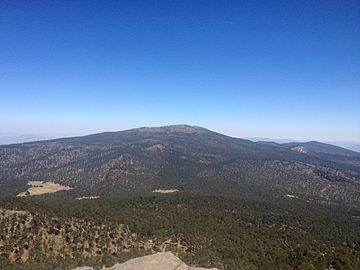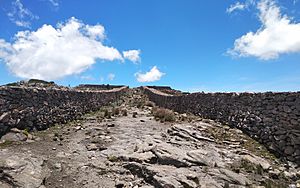Mount Tlaloc facts for kids
Quick facts for kids Mount Tlaloc |
|
|---|---|

Mount Tláloc from the summit of Telapón
|
|
| Highest point | |
| Elevation | 4,120 m (13,520 ft) |
| Prominence | 920 m (3,020 ft) |
| Listing |
|
| Geography | |
| Location | Ixtapaluca and Texcoco municipalities, State of Mexico, Mexico |
| Geology | |
| Age of rock | Plio-Pleistocene |
| Mountain type | Stratovolcano |
| Volcanic arc/belt | Trans-Mexican Volcanic Belt |
| Climbing | |
| Easiest route | hike |
Mount Tlaloc (in Spanish: Monte Tláloc, and in Nahuatl: Tlālōcatepētl) is a famous mountain and ancient archaeological site in central Mexico. It stands tall in the State of Mexico, near the border with Puebla. This mountain was once an active volcano. It reaches an altitude of 4,120 meters (13,517 feet) above sea level. This makes it the 9th tallest mountain in all of Mexico.
Ancient peoples, especially the Nahuan peoples like the Aztecs, believed Mount Tlaloc was very special. They thought it was a main home for the rain god Tlaloc, calling it Tlalocan. People believed mountains were sacred to rain gods long before the Aztecs. At the top of Mount Tlaloc, you can still find parts of an old shrine. Important ceremonies likely took place there. The shrine on Mount Tlaloc is one of the highest ancient shrines in the world.
Mount Tlaloc is part of the "Sierra de Río Frío" mountain range. This range is the northernmost tip of the Sierra Nevada. You can easily reach the mountain from Federal Highway 150 near the town of Río Frío de Juárez. The hike up is long but not too difficult, gaining over 1,200 meters (3,937 feet) in height.
Contents
Geology of Mount Tlaloc
Mount Tlaloc is an old stratovolcano that has been worn down over time. It is the oldest and most northern volcano in a chain of volcanoes. This chain stretches south towards Popocatépetl. Volcanic activity on Tlaloc began during the Pliocene epoch. It continued until the Late Pleistocene epoch. About 31,500 years ago, a huge Plinian eruption happened. This eruption sent out hot ash and gases, creating pyroclastic flows. It also left a thick layer of pumice rock.
The Mountain's Sacred Area
At the very top of Mount Tlaloc, there is an enclosed area. You could reach this area by following a path up the mountain. The entrance was on the western side of the enclosure. The walls of this sacred space were made mostly of pumice and tufa. These rocks were easy to find nearby and shape because they are soft.
Inside this area, called a tetzacualo or courtyard, there are five rock formations. One rock is in the center, and four are at the corners. The center rock might represent Tlaloc himself. The four corner rocks could stand for his four rain forms, linked to the four directions. These five rocks together may represent the Tlaloque. The Tlaloque were spirits believed to use water vessels to bring rain across the land. One side of the courtyard also had a structure that held a statue of Tlaloc. It also held other idols representing nearby sacred places. This special area was very important for asking the Tlaloque for good crops and to help the people of Mesoamerica.
Ancient Rituals and Practices
The Aztecs performed many rituals to ensure rain for their lands. They held grand ceremonies and offered many gifts to Tlaloc. These rituals happened several times a year, especially when the rainy season began. One yearly celebration was called Huey Tozoztli. It took place on Mount Tlaloc, usually in April. This was right before the start of the rainy season, when temperatures were highest. Rulers and important people from Tenochtitlan and nearby cities like Xochimilco and Tlaxcala would join this feast.
Another ceremony on Mount Tlaloc was Atlachualo. This was celebrated from mid-February to early March. During this ceremony, children were dressed "like gods." They were taken to the mountain top for ceremonial purposes. The children's tears were seen as a symbol of heavy rains. If they did not cry on their own, their fingernails were sometimes removed to make them cry. The main goal of these offerings was to please Tlaloc and the Tlaloque. This was done to make sure there would be enough rain for the summer growing season.
Archaeological Discoveries
Researchers have studied the damage to the walls of the enclosure on Mount Tlaloc. They believe the damage was caused by people, not just by nature. When the site was first explored, it was covered with pieces of green stone. There were also shards of pottery and sharp obsidian blades. Archaeologists think the site might have been used until the end of the Christian era. The modern shrine you see at the summit today was likely built around the 1970s. An aerial photo from 1956 does not show the current statue.
Images for kids
See also
 In Spanish: Monte Tláloc para niños
In Spanish: Monte Tláloc para niños
- Aztec mythology
- List of mountain peaks of Mexico
- Tlaloc




